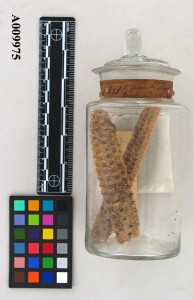 Another great find from the recent issue of The Plant Press I blogged about yesterday is the Smithsonian’s website on Edward Palmer:
Another great find from the recent issue of The Plant Press I blogged about yesterday is the Smithsonian’s website on Edward Palmer:
Edward Palmer (1831-1911), often regarded as “the father of ethnobotany,” gathered extensive natural history collections in North and South America during the late nineteenth century and established standards for plant collecting and reporting, particularly for plants useful to people. His scientific framework is still used today. This new Botany website, Edward Palmer Collections provides a window into the Palmer Collection to communities where Palmer originally collected, as well as to scientists and the general public.
Palmer held posts both as ethnologist for the Smithsonian and as USDA plant collector, and the connections between his botanical and anthropological materials are fascinating, and nicely highlighted on the website. Now, is anyone going to try to get DNA out of his corncob?

